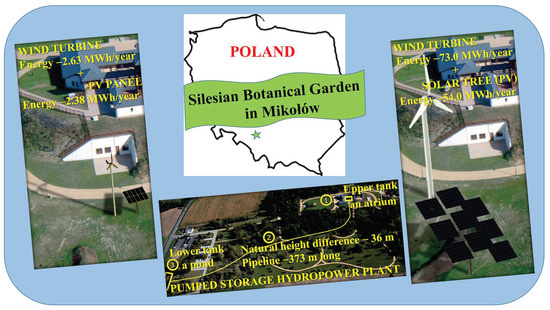Installation’s Conception in the Field of Renewable Energy Sources for the Needs of the Silesian Botanical Garden
Abstract
1. Introduction
- Solar energy—energy from the sun
- Wind energy—energy from onshore wind or floating offshore wind
- Water energy—energy related to rainfall, tides, and ocean waves
- Geothermal energy—energy from heat inside the earth or from the soil
- Biomass or bioenergy, biogas, the energy from organic matter
2. Silesian Botanical Garden
2.1. History of the Garden
2.2. Mission of the Garden
- Reducing the costs of current energy consumption;
- Ensuring continuity of energy supply;
- The smallest possible interference on the Garden’s landscape;
- Small area occupation;
- As minimal as possible earthworks in the realization of structures;
- No negative impact of energy sources on the ecosystem of the SBG and the condition of the CEEE building.
3. Materials and Methods
3.1. Climatic Conditions in the Area of Sośnia Góra
- The measurements taken at the meteorological station located in the Silesian Botanical Garden in Mikołów [74];
- The measurements made by the University of Silesia, Faculty of Natural Sciences in Sosnowiec (Poland), Institute of Earth Sciences [75];
- The measurements made by the “European Commission Joint Research Center; Ispra, Italy”—Photovoltaic Geographical Information System [76].
3.1.1. Data from the Meteorological Station Located in the Area of the SBG
3.1.2. Data from the Meteorological Station of the University of Silesia
3.1.3. Data from “the European Commission Joint Research Centre; Ispra, Italy”—Photovoltaic Geographical Information System (PVGIS)
3.1.4. Wind Conditions in the Area of Sośnia Góra
3.1.5. Insolation in the Area of Sośnia Góra
3.2. Analysis of the CEPiE Building’s Demand for Energy (Energy Audit)
- Lighting of the Garden’s area;
- Power of the monitoring equipment;
- Energy demand of the building constituting the seat of the Garden’s security;
- A value of energy demand equal to 130 MWh/year assumed for further calculations.
3.3. Conceptions of the Solutions
3.3.1. First Conception
- SWIND 3200 horizontal axis wind turbine with: (1) a rated power (Pt) of 3.2 kW (for a rated wind speed equal to 10.8 m/s), (2) a maximum power (Pmax) of 4.0 kW (for cut-out wind speed equal to 15 m/s), (3) a cut-in wind speed (vstart) of 2.8 m/s, (4) a blade diameter of 3.5 m, and (5) a tower height of 12.0 m [85].
- a PV panel with a total size of 5.0 × 4.0 m, containing a set of 10 polycrystalline modules NBJ-250P (1950 × 990 × 50 mm each) with 72 photovoltaic cells (156 × 156 mm each), with a rated power of 250 W (for a single cell) [86], mounted along with the tracker on a 5 m high column.
3.3.2. Second Conception
- Zefir D21-P70-T18 horizontal axis wind turbine with: (1) a rated power (Pt) of 70 kW (for rated wind speed equal to 9.6 m/s), (2) a maximum power (Pmax) of 78.0 kW (for cut-out wind speed equal to 10 m/s), (3) a cut-in wind speed (vstart) of 3.0 m/s, (4) a blade diameter of 21.0 m, and (5) a tower height of 30.0 m [87].
- Nine PV panels each containing 24 polycrystalline modules NBJ-250P (1950 × 990 × 50 mm each), with 218 photovoltaic cells (156 × 156 mm each), with a rated power of 250 W (for a single cell) [86], mounted along with trackers on a specially designed tree-shaped supporting structure, consisting of an 18 m high support column and eight branches with lengths of 9.57 m to 12.04 m [77].
3.3.3. Third Conception
3.3.4. Selection of the Conception
4. Results and Discussion
4.1. Soil-Water Conditions
- Mainly semi-solid silty clays and sandy clays (about 0.7 m below the surface);
- Semi-solid and solid clays;
- Deeper (below 4.5 to 5.0 m), a soft rock (limestone), strongly fractured, with a compressive strength up to 5 MPa.
4.2. Shape of the Designed Structures and the List of Loads
4.2.1. Wind Turbine
- Combination (54): bending moment M = 2972.0 kNm, horizontal force H = 112.0 kN, normal force Vx = 327.0 kN;
- Combination (55): bending moment M = 4182.0 kNm, horizontal force H = 159.0 kN, normal force Vx = 278.0 kN.
4.2.2. Hybrid System—Supporting Structure with Photovoltaic Panels and Tracker
- Work of the construction as an array;
- Work of the structure as a plane with a 45-degree slope;
- Work of the structure as a plane with a 0-degree slope.
- Combination (48): bending moments My = 7.4 kNm and Mz = 30,202.0 kNm, horizontal force Hy = 1866.0 kN, normal force V = 974.0 kN;
- Combination (124): bending moments My = 28,122.0 kNm and Mz = 20.1 kNm, horizontal force Hz = 1728.0 kN, normal force V = 937.0 kN.
4.3. Foundation of the Structure
4.3.1. Foundation of a Wind Turbine
- For soil (clay): oedometric compressibility modulus M0 = 25.0 MPa, Poisson’s ratio ν = 0.37, unit weight γ = 21.5 kN/m3, internal friction angle φ = 13°, soil cohesion c = 60.0 kPa, and dilatation angle ψ = 2.0°;
- For concrete: deformation modulus E0 = 31.0 GPa, Poisson’s ratio ν = 0.20, and unit weight γ = 25.0 kN/m3.
- Depth of the foundation—D = 1.80 m;
- Radius of the column—r = 1.00 m;
- Radius of the footing—R = 3.25 m;
- Thickness of the footing—h = 0.80 m.
- Pile diameter d = 2.0 m (an analogous to the shaft of the foundation);
- Pile length from ground level h = 13.0 m;
- Concrete type C25/30 with compressive strength equal to 25 MPa [112];
- Manufacturing technology—the large-diameter bored pile with a temporary (recoverable) steel casing.
4.3.2. Foundation of a Supporting Structure for Photovoltaic Panels and a Tracker
- For soil (clay): oedometric compressibility modulus M0 = 25.0 MPa, Poisson’s ratio ν = 0.37, unit weight γ = 21.5 kN/m3, internal friction angle φ = 13°, soil cohesion c = 60.0 kPa, and dilatation angle ψ = 2.0°;
- For concrete: deformation modulus E0 = 35.0 GPa, Poisson’s ratio ν = 0.20, and unit weight γ = 25.0 kN/m3.
4.4. Conception of a Pumped Storage Power Plant
4.4.1. Selection of a Water Turbine
4.4.2. Analysis of the Required Energy Capacity—The Water Reservoirs
- An empty reservoir loaded with the soil pressure (the most unfavorable load system);
- A full reservoir loaded with the hydrostatic pressure of water on one side, and with the soil pressure on the other side;
- A partially full reservoir.
- Finally, the internal forces were determined in the Autodesk Robot Structural Analysis Professional program. The values of bending moments in the structure are shown in Figure 13. Due to its specific localization, a diaphragm-walls technology was proposed to construct the reservoir under-ground. After the construction works are completed, it is possible to recreate the original surface from paving stones in the atrium.
4.4.3. Pressure Pipeline
5. Conclusions
- Despite the fact that renewable energy production devices provide general guidelines regarding their loads, foundations, etc., depending on the situation (values of loading forces, soil and water conditions, topography, climatic conditions, energy demand), the persons responsible for the project should perform an independent detailed case study with calculations using, e.g., the finite element method. For this purpose, the cooperation of many specialists, including geotechnical/electrical/mechanical/aerodynamic engineers and climatologists, among others, is necessary;
- Another important conclusion concerns the detailed analysis of local weather conditions (wind conditions, insolation) and the topography. Climatic data should preferably come from a period of several years and correspond to the expected location of RESs devices, including height above the ground surface;
- A good recognition of soil-water conditions (an important function of a geotechnical engineer) is necessary not only for the correct foundation of RESs devices subjected to high loads from wind, temperature, and snow. Knowing the subsoil is essential if the use of geothermal energy from the soils or rocks is being considered. The foundation of the wind turbine on a monopile allows it to be treated as a heating foundation. In addition, a wind turbine or other renewable energy systems can be used to directly supply the heat pump with electricity;
- The off-grid solution with an autonomous installation, not connected to the electric grid, includes: (1) a Zefir D21-P70-T18 wind turbine with a power of 70 kW and a height of 30 m; (2) a set of 218 polycrystalline NBJ-250P photovoltaic cells with a total power of 54.0 kW and dimensions of each element equal to 1.65 × 0.99 m that, along with the tracker, are mounted on a specifically designed tree-shaped supporting structure, consisting of a support column and the eight branches; and (3) additionally, to store surplus of energy, a pumped storage power plant with: (a) a Deriaza water turbine, (b) an upper reservoir with a volume of 4320 m3 (20 m × 20 m × 10.8 m), and (c) a natural pond as a lower reservoir. This solution meets all the requirements for the Silesian Botanical Garden;
- The proposed hybrid system which may be called a Solar tree (in this case, a tree-like supporting structure with photovoltaic cells as foundation) can be considered a base solution, but its final shape and total power will depend on specific conditions (location and energy demand) and detailed analyses. Indeed, similar initiatives are carried out elsewhere in the world, but the solar trees are still perceived as “futuristic”. The 18 most iconic giant solar supertrees (up to 50 meters above ground) in Singapore’s Gardens by the Bay are the best example of this [129]. It is worth mentioning the wind tree prototype designed by entrepreneur Jérôme Michaud-Larivière, which was first installed in Paris in December 2015. The innovative tree-like structure which is 12 m high and 7 m wide is composed of three steel trunks that stem into tinier branches on which the 36 leaf-shaped wind turbines are attached (the vertical-axis Savonius micro wind turbines 70 cm high called an “aero-leaf”). This solution is intended for both urban (mainly) and rural applications and is currently available in France [130]. Both the proposed solar tree and the wind tree of the NewWind company, as innovations, might lead to other ideas and technologies;
- The analysis showed that even a slight difference in terrain levels make it possible to construct a pumped storage hydropower plant (PSHP). Furthermore, this PSHP can be perfectly integrated into the existing atrium of the building of the Center for Ecological and Environmental Education (CEEE) in Sośnia Góra. An interesting and innovative solution, which is the pilot project Gaildorf near Stuttgart in Bavaria (Germany), is worth mentioning [131,132]. The integrated fully automated system includes: (1) four wind turbines with heights of 150 to 223 m above sea level, rotor diameters of 103 to 137 m, and powers of 3.2 to 3.8 MW, as well as (2) a pumped storage hydropower plant in which (a) the foundations of the hybrid wind turbine towers also function as upper water reservoirs (a total of 160,000 m3 of water can be stored, and an energy capacity of 70 MWh is ensured), while (b) the lower tank is a natural water Gaildorf-Unterrot reservoir in the Kochertal valley at a distance of 3.2 km (200 m in the vertical line), connected to the hybrid towers by (c) the patented thermoplastic pipeline, and (d) equipped with reversible Francis turbines. This modern wind farm with innovative energy storage began its operation in 2018. Currently, ‘Hybrid Tower’ concepts are being implemented in the North American market, in Thailand, Japan, and Austria, making a significant contribution to climate protection and resource efficiency.
Funding
Institutional Review Board Statement
Informed Consent Statement
Data Availability Statement
Acknowledgments
Conflicts of Interest
References
- Jastrzębska, M.; Wawrzyńczyk, B. The Analysis of The Direct Foundation with Energy Foundations on the Basis of The Office Building “A4 Business Park” In Katowice at Francuska Street. Arch. Civ. Eng. Environ. 2016, 9, 65–76. [Google Scholar] [CrossRef]
- Benedek, J.; Sebestyén, T.-T.; Bartók, B. Evaluation of renewable energy sources in peripheral areas and renewable energy-based rural development. Renew. Sustain. Energy Rev. 2018, 90, 516–535. [Google Scholar] [CrossRef]
- Wang, Y.; Sun, T. Life cycle assessment of CO2 emissions from wind power plants: Methodology and case studies. Renew. Energy 2012, 43, 30–36. [Google Scholar] [CrossRef]
- Schreiber, A.; Marx, J.; Zapp, P. Comparative life cycle assessment of electricity generation by different wind turbine types. J. Clean. Prod. 2019, 233, 561–572. [Google Scholar] [CrossRef]
- Smoucha, E.A.; Fitzpatrick, K.; Buckingham, S.; Knox, O.G.G. Life Cycle Analysis of the Embodied Carbon Emissions from 14 Wind Turbines with Rated Powers between 50 Kw and 3.4 Mw. J. Fundam. Renew. Energy Appl. 2016, 6, 1000211. [Google Scholar] [CrossRef]
- Chandrasekharam, D.; Ranjith Pathegama, G. CO2 emissions from renewables: Solar pv, hydrothermal and EGS sources. Géoméch. Geophys. Geo-Energy Geo-Resour. 2020, 6, 13. [Google Scholar] [CrossRef]
- Chowdhury, M.D.S.; Rahman, K.S.; Chowdhury, T.; Nuthammachot, N.; Techato, K.; Akhtaruzzaman, M.D.; Tiong, S.K.; Sopian, K.; Nowshad Amin, N. An Overview of Solar Photovoltaic Panels’ End-of-life Material Recycling. Energy Strategy Rev. 2020, 27, 100431. [Google Scholar] [CrossRef]
- Włodarczyk, R. Analysis of the Photovoltaic Waste-recycling Process in Polish Conditions—A Short Review. Sustainability 2022, 14, 4739. [Google Scholar] [CrossRef]
- Schoden, F.; Dotter, M.; Knefelkamp, D.; Blachowicz, T.; Schwenzfeier Hellkamp, E. Review of State of the Art Recycling Methods in the Context of Dye Sensitized Solar Cells. Energies 2021, 14, 3741. [Google Scholar] [CrossRef]
- Taras, P.; Nilifard, R.; Zhu, Z.-Q.; Azar, Z. Cooling Techniques in Direct-Drive Generators for Wind Power Application. Energies 2022, 15, 5986. [Google Scholar] [CrossRef]
- Wang, W.; Xue, Y.; He, C.; Zhao, Y. Review of the Typical Damage and Damage-Detection Methods of Large Wind Turbine Blades. Energies 2022, 15, 5672. [Google Scholar] [CrossRef]
- Le, T.-C.; Luu, T.-H.; Nguyen, H.-P.; Nguyen, T.-H.; Ho, D.-D.; Huynh, T.-C. Piezoelectric Impedance-Based Structural Health Monitoring of Wind Turbine Structures: Current Status and Future Perspectives. Energies 2022, 15, 5459. [Google Scholar] [CrossRef]
- Farhat, H.; Salvini, C. Novel Gas Turbine Challenges to Support the Clean Energy Transition. Energies 2022, 15, 5474. [Google Scholar] [CrossRef]
- Jaen-Cuellar, A.Y.; Elvira-Ortiz, D.A.; Osornio-Rios, R.A.; Antonino-Daviu, J.A. Advances in Fault Condition Monitoring for Solar Photovoltaic and Wind Turbine Energy Generation: A Review. Energies 2022, 15, 5404. [Google Scholar] [CrossRef]
- Gambier, A. Multiobjective Optimal Control ofWind Turbines: A Survey on Methods and Recommendations for the Implementation. Energies 2022, 15, 567. [Google Scholar] [CrossRef]
- Malliotakis, G.; Alevras, P.; Baniotopoulos, C. Recent Advances in Vibration Control Methods for Wind Turbine Towers. Energies 2021, 14, 7536. [Google Scholar] [CrossRef]
- Benbouzid, M.; Berghout, T.; Sarma, N.; Djurović, S.; Wu, Y.; Ma, X. Intelligent Condition Monitoring of Wind Power Systems: State of the Art Review. Energies 2021, 14, 5967. [Google Scholar] [CrossRef]
- Lu, L.; Zhu, M.; Wu, H.; Wu, J. A Review and Case Analysis on Biaxial Synchronous Loading Technology and Fast Moment-Matching Methods for Fatigue Tests of Wind Turbine Blades. Energies 2022, 15, 4881. [Google Scholar] [CrossRef]
- Pacheco, J.; Pimenta, F.; Pereira, S.; Cunha, Á.; Magalhães, F. Fatigue Assessment of Wind Turbine Towers: Review of Processing Strategies with Illustrative Case Study. Energies 2022, 15, 4782. [Google Scholar] [CrossRef]
- Krajewski, D.; Oleksy, M.; Oliwa, R.; Bulanda, K.; Czech, K.; Mazur, D.; Masłowski, G. Methods for Enhancing the Electrical Properties of Epoxy Matrix Composites. Energies 2022, 15, 4562. [Google Scholar] [CrossRef]
- Olubamiwa, O.I.; Gule, N. A Review of the Advancements in the Design of Brushless Doubly Fed Machines. Energies 2022, 15, 725. [Google Scholar] [CrossRef]
- Adkins, K.A.; Sescu, A. Wind Farms and Humidity. Energies 2022, 15, 2603. [Google Scholar] [CrossRef]
- Contreras Montoya, L.T.; Lain, S.; Ilinca, A. A Review on the Estimation of Power Loss Due to Icing in Wind Turbines. Energies 2022, 15, 1083. [Google Scholar] [CrossRef]
- Asim, T.; Islam, S.Z.; Hemmati, A.; Khalid, M.S.U. A Review of Recent Advancements in Offshore Wind Turbine Technology. Energies 2022, 15, 579. [Google Scholar] [CrossRef]
- Arredondo-Galeana, A.; Brennan, F. Floating Offshore Vertical Axis Wind Turbines: Opportunities, Challenges and Way Forward. Energies 2021, 14, 8000. [Google Scholar] [CrossRef]
- Rajpar, A.H.; Ali, I.; Eladwi, A.E.; Bashir, M.B.A. Recent Development in the Design of Wind Deflectors for Vertical Axis Wind Turbine: A Review. Energies 2021, 14, 5140. [Google Scholar] [CrossRef]
- Olabi, A.G.; Wilberforce, T.; Elsaid, K.; Salameh, T.; Sayed, E.T.; Husain, K.S.; Abdelkareem, M.A. Selection Guidelines for Wind Energy Technologies. Energies 2021, 14, 3244. [Google Scholar] [CrossRef]
- Mathern, A.; von der Haar, C.; Marx, S. Concrete Support Structures for Offshore Wind Turbines: Current Status, Challenges, and Future Trends. Energies 2021, 14, 1995. [Google Scholar] [CrossRef]
- Sattar, M.; Rehman, A.; Ahmad, N.; Mohammad, A.-S.; Al Ahmadi, A.A.; Ullah, N. Performance Analysis and Optimization of a Cooling System for Hybrid Solar Panels Based on Climatic Conditions of Islamabad, Pakistan. Energies 2022, 15, 6278. [Google Scholar] [CrossRef]
- Hasan, H.A.; Sherza, J.S.; Mahdi, J.M.; Togun, H.; Abed, A.M.; Ibrahim, R.K.; Yaïci, W. Experimental Evaluation of the Thermoelectrical Performance of Photovoltaic-Thermal Systems with a Water-Cooled Heat Sink. Sustainability 2022, 14, 10231. [Google Scholar] [CrossRef]
- Sornek, K.; Goryl, W.; Figaj, R.; Dąbrowska, G.; Brezdeń, J. Development and Tests of the Water Cooling System Dedicated to Photovoltaic Panels. Energies 2022, 15, 5884. [Google Scholar] [CrossRef]
- Hajjaj, S.S.H.; Aqeel, A.A.K.A.; Sultan, M.T.H.; Shahar, F.S.; Shah, A.U.M. Review of Recent Efforts in Cooling Photovoltaic Panels (PVs) for Enhanced Performance and Better Impact on the Environment. Nanomaterials 2022, 12, 1664. [Google Scholar] [CrossRef] [PubMed]
- Goudelis, G.; Lazaridis, P.I.; Dhimish, M. A Review of Models for Photovoltaic Crack and Hotspot Prediction. Energies 2022, 15, 4303. [Google Scholar] [CrossRef]
- Hopwood, M.W.; Stein, J.S.; Braid, J.L.; Seigneur, H.P. Physics-Based Method for Generating Fully Synthetic IV Curve Training Datasets for Machine Learning Classification of PV Failures. Energies 2022, 15, 5085. [Google Scholar] [CrossRef]
- Yu, J.; Yang, Y.; Zhang, H.; Sun, H.; Zhang, Z.; Xia, Z.; Zhu, J.; Dai, M.; Wen, H. Spectrum Analysis Enabled Periodic Feature Reconstruction Based Automatic Defect Detection System for Electroluminescence Images of Photovoltaic Modules. Micromachines 2022, 13, 332. [Google Scholar] [CrossRef]
- Yan, B.; Wu, Q.; Chi, X.; Wu, C.; Luo, P.; Luo, Y.; Zeng, P. Numerical and Experimental Investigation of Photovoltaic/Thermal Systems: Parameter Analysis and Determination of Optimum Flow. Sustainability 2022, 14, 10156. [Google Scholar] [CrossRef]
- Umam, M.F.; Hasanuzzaman, M.; Rahim, N.A. Global Advancement of Nanofluid-Based Sheet and Tube Collectors for a Photovoltaic Thermal System. Energies 2022, 15, 5667. [Google Scholar] [CrossRef]
- Kopecek, R.; Libal, J. Bifacial Photovoltaics 2021: Status, Opportunities and Challenges. Energies 2021, 14, 2076. [Google Scholar] [CrossRef]
- Pastuszak, J.; Węgierek, P. Photovoltaic Cell Generations and Current Research Directions for Their Development. Materials 2022, 15, 5542. [Google Scholar] [CrossRef]
- Arsalis, A.; Georghiou, G.E.; Papanastasiou, P. Recent Research Progress in Hybrid Photovoltaic–Regenerative Hydrogen Fuel Cell Microgrid Systems. Energies 2022, 15, 3512. [Google Scholar] [CrossRef]
- Gnida, P.; Amin, M.F.; Pająk, A.K.; Jarząbek, B. Polymers in High-Efficiency Solar Cells: The Latest Reports. Polymers 2022, 14, 1946. [Google Scholar] [CrossRef] [PubMed]
- Maafa, I.M. All-Inorganic Perovskite Solar Cells: Recent Advancements and Challenges. Nanomaterials 2022, 12, 1651. [Google Scholar] [CrossRef] [PubMed]
- Roy, P.; Ghosh, A.; Barclay, F.; Khare, A.; Cuce, E. Perovskite Solar Cells: A Review of the Recent Advances. Coatings 2022, 12, 1089. [Google Scholar] [CrossRef]
- Romeo, A.; Artegiani, E. CdTe-Based Thin Film Solar Cells: Past, Present and Future. Energies 2021, 14, 1684. [Google Scholar] [CrossRef]
- Hanifi, H.; Jaeckel, B.; Pander, M.; Dassler, D.; Kumar, S.; Schneider, J. Techno-Economic Assessment of Half-Cell Modules for Desert Climates: An Overview on Power, Performance, Durability and Costs. Energies 2022, 15, 3219. [Google Scholar] [CrossRef]
- Bogdanowicz, K.A. Bi-Triggering Energy Harvesters: Is It Possible to Generate Energy in a Solar Panel under Any Conditions? Energies 2021, 14, 5796. [Google Scholar] [CrossRef]
- Romaní, J.; Ramos, A.; Salom, J. Review of Transparent and Semi-Transparent Building-Integrated Photovoltaics for Fenestration Application Modeling in Building Simulations. Energies 2022, 15, 3286. [Google Scholar] [CrossRef]
- Marques Lameirinhas, R.A.; Torres, J.P.N.; de Melo Cunha, J.P. A Photovoltaic Technology Review: History, Fundamentals and Applications. Energies 2022, 15, 1823. [Google Scholar] [CrossRef]
- Nordin, N.A.; Ansari, M.N.; Nomanbhay, S.M.; Hamid, N.A.; Tan, N.M.L.; Yahya, Z.; Abdullah, I. Integrating Photovoltaic (PV) Solar Cells and Supercapacitors for Sustainable Energy Devices: A Review. Energies 2021, 14, 7211. [Google Scholar] [CrossRef]
- Ramos, H.M.; Vargas, B.; Saldanha, J.R. New Integrated Energy Solution Idealization: Hybrid for Renewable Energy Network (Hy4REN). Energies 2022, 15, 3921. [Google Scholar] [CrossRef]
- Kim, W.-J.; Lee, Y.-S.; Chun, Y.-H.; Jeong, H.-S. Reserve-Constrained Unit Commitment Considering Adjustable-Speed Pumped-Storage Hydropower and Its Economic Effect in Korean Power System. Energies 2022, 15, 2386. [Google Scholar] [CrossRef]
- Medveď, D.; Kolcun, M.; Pavlík, M.; Beňa, Ľ.; Mešter, M. Analysis of Prosumer Behavior in the Electrical Network. Energies 2021, 14, 8212. [Google Scholar] [CrossRef]
- Chaima, E.; Lian, J.; Ma, C.; Zhang, Y.; Kavwenje, S. Complementary Optimization of Hydropower with Pumped Hydro Storage–Photovoltaic Plant for All-Day Peak Electricity Demand in Malawi. Energies 2021, 14, 4948. [Google Scholar] [CrossRef]
- Storli, P.-T.; Lundström, T.S. A New Technical Concept for Water Management and Possible Uses in Future Water Systems. Water 2019, 11, 2528. [Google Scholar] [CrossRef]
- Cicėnas, P.; Radziukynas, V. Developed Transfer Function Allows Hydro Generators to Enter the Full Range of Ancillary Services Market. Energies 2022, 15, 397. [Google Scholar] [CrossRef]
- Wang, Y.; Fang, G. Joint Operation Modes and Economic Analysis of Nuclear Power and Pumped Storage Plants under Different Power Market Environments. Sustainability 2022, 14, 9128. [Google Scholar] [CrossRef]
- Zhang, Q.; Zheng, Y. Geotechnical Investigations and Support Design for an Underground Powerhouse of Pumped-Storage Power Station: A Case Study in Chongqing, China. Sustainability 2022, 14, 8481. [Google Scholar] [CrossRef]
- Chu, Y.; Pan, Y.; Zhan, H.; Cheng, W.; Huang, L.; Wu, Z.; Shao, L. Systems Accounting for Carbon Emissions by Hydropower Plant. Sustainability 2022, 14, 6939. [Google Scholar] [CrossRef]
- Pujades, E.; Poulain, A.; Orban, P.; Goderniaux, P.; Dassargues, A. The Impact of Hydrogeological Features on the Performance of Underground Pumped-Storage Hydropower (UPSH). Appl. Sci. 2021, 11, 1760. [Google Scholar] [CrossRef]
- Špano, M.; Říha, J.; Španová, A.; Šedo, O.; Rittich, B. Bacterial Diversity in the Asphalt Concrete Lining of the Upper Water Reservoir of a Pumped-Storage Scheme. Water 2020, 12, 3045. [Google Scholar] [CrossRef]
- Kobler, U.G.; Wüest, A.; Schmid, M. Effects of Lake–Reservoir Pumped-Storage Operations on Temperature and Water Quality. Sustainability 2018, 10, 1968. [Google Scholar] [CrossRef]
- Wessel, M.; Madlener, R.; Hilgers, C. Economic Feasibility of Semi-Underground Pumped Storage Hydropower Plants in Open-Pit Mines. Energies 2020, 13, 4178. [Google Scholar] [CrossRef]
- Kitsikoudis, V.; Archambeau, P.; Dewals, B.; Pujades, E.; Orban, P.; Dassargues, A.; Pirotton, M.; Erpicum, S. Underground Pumped-Storage Hydropower (UPSH) at the Martelange Mine (Belgium): Underground Reservoir Hydraulics. Energies 2020, 13, 3512. [Google Scholar] [CrossRef]
- Pujades, E.; Orban, P.; Archambeau, P.; Kitsikoudis, V.; Erpicum, S.; Dassargues, A. Underground Pumped-Storage Hydropower (UPSH) at the Martelange Mine (Belgium): Interactions with Groundwater Flow. Energies 2020, 13, 2353. [Google Scholar] [CrossRef]
- Lugauer, F.J.; Kainz, J.; Gehlich, E.; Gaderer, M. Roadmap to Profitability for a Speed-Controlled Micro-Hydro Storage System Using Pumps as Turbines. Sustainability 2022, 14, 653. [Google Scholar] [CrossRef]
- Wang, L.; Zhang, K.; Zhao, W. Nonlinear Modeling of Dynamic Characteristics of Pump-Turbine. Energies 2022, 15, 297. [Google Scholar] [CrossRef]
- Deng, Y.; Xu, J.; Li, Y.; Zhang, Y.; Kuang, C. Research on Energy Loss Characteristics of Pump-Turbine during Abnormal Shutdown. Processes 2022, 10, 1628. [Google Scholar] [CrossRef]
- Miller, H.; Bailey, C.; Smith, P. The Role of Botanic Gardens in Practising and Promoting Environmental Sustainability. BGCI Technical Review. April 2020, Published by Botanic Gardens Conservation International, Descanso House, Richmond, Surrey, TW9 3BW, U.K. pp. 1–35. Available online: https://www.bgci.org/wp/wp-content/uploads/2020/04/ReviewMedRes.pdf (accessed on 31 August 2022).
- Cincinnati Zoo and Botanical Garden. Available online: https://cincinnatizoo.org/news-releases/cincinnati-zoo-using-wind-power-to-go-green/ (accessed on 3 August 2022).
- Edinburgh’s Royal Botanic Garden. Available online: https://commons.wikimedia.org/wiki/File:Wind_turbine_at_the_Royal_Botanic_Garden_Edinburgh_-_geograph.org.uk_-_1764786.jpg (accessed on 3 August 2022).
- Boston’s Museum of Science. Available online: https://www.npr.org/templates/story/story.php?storyId=112298310 (accessed on 3 August 2022).
- Laayati, O.; El Hadraoui, H.; Guennoui, N.; Bouzi, M.; Chebak, A. Smart Energy Management System: Design of a Smart Grid Test Bench for Educational Purposes. Energies 2022, 15, 2702. [Google Scholar] [CrossRef]
- Martin, S.S.; Chebak, A. Concept of educational renewable energy laboratory integrating wind, solar and biodiesel energies. Int. J. Hydrogen Energy 2016, 41, 21036–21046. [Google Scholar] [CrossRef]
- Informational materials: Data from the meteorological station of the Silesian Botanical Garden in Mikołów, 2013. Own documentation of the SBG’s director made available directly to the author of this study in January 2014. (In Polish)
- Informational materials: Data from the meteorological station of the University of Silesia, Faculty of Earth Sciences in Sosnowiec, 2013. Data prepared by Tomasz Dudzik, MA in the form of an *.xls file and made available directly to the author of this study in January 2014. (In Polish)
- Informational materials: Meteorological Data from the PVGIS (c) European Communities, 2001–2012. Available online: http://re.jrc.ec.europa.eu/pvgis/ (accessed on 7 March 2014).
- Ćwirko, M.; Piotrowicz, B. Analysis of the RES System and the Method of Its Foundation in Area of the Sośnia Góra in Mikołów. Master’s Thesis, Silesian University of Technology, Gliwice, Poland, 2014. (In Polish). [Google Scholar]
- Dz. U. 1994, nr 89 poz. 414. Law from 7 Jule 1994. Construction Law. Available online: https://isap.sejm.gov.pl/isap.nsf/DocDetails.xsp?id=wdu19940890414#collapse_14 (accessed on 15 March 2014). (In Polish)
- Directive 2002/91/EC of the European Parliament and of the Council of 16 December 2002 on the Energy Performance of Buildings. Special Edition: Chapter 12, Volume 002. Available online: https://eur-lex.europa.eu/eli/dir/2002/91/oj (accessed on 15 March 2014). (In Polish).
- Jastrzębska, M. Silesian Botanical Garden (part 1)—Analysis of energy needs and the possibilities of providing them. In Garden and Park Assumptions in Contemporary Cities. Selected Aspects of Programming the Transformation of the Silesian Botanical Garden in Mikołów; Rabiej, J., Ed.; Silesian University of Technology: Gliwice, Poland, 2016; Volume 9, pp. 103–114. (In Polish) [Google Scholar]
- Informational materials of Mikołów commune: Energy Performance Certificate No. 5/2010 for the building of the Centre for Ecological and Environmental Education (CEEE), November 2010. Own documentation of the Mayor of Mikołów commune made available directly to the author of this study in January 2014. (In Polish)
- Informational materials of Mikołów commune: Balance of the current consumption of utilities (electricity, water and liquid fuel) for the building of the Centre for Ecological and Environmental Education (CEEE), October 2013. Own documentation of the Mayor of Mikołów commune made available directly to the author of this study in January 2014. (In Polish)
- Jastrzębska, M. Silesian Botanical Garden (part 2)—Analysis of design solutions for the foundations of a wind turbine and supporting structure of photovoltaic panels with a tracker. In Garden and Park Assumptions in Contemporary Cities. Selected Aspects of Programming the Transformation of the Silesian Botanical Garden in Mikołów; Rabiej, J., Ed.; Silesian University of Technology: Gliwice, Poland, 2016; Volume 10, pp. 115–126. (In Polish) [Google Scholar]
- Piotrowicz, B.; Jastrzębska, M. Silesian Botanical Garden (part 3)—Guidelines for the design of pumped storage power plants for energy storage in autonomous installations based on renewable energy sources. In Garden and Park Assumptions in Contemporary Cities. Selected Aspects of Programming the Transformation of the Silesian Botanical Garden in Mikołów; Rabiej, J., Ed.; Silesian University of Technology: Gliwice, Poland, 2016; Volume 11, pp. 127–136. (In Polish) [Google Scholar]
- SWIND 3200. Available online: www.docplayer.pl/6154730-Mala-przydomowa-elektrownia-wiatrowa-swind-3200.html (accessed on 11 March 2014). (In Polish).
- NBJ-250P. Available online: www.enfsolar.com/Product/pdf/Crystalline/50fcc1d3a8234.pdf (accessed on 11 March 2014).
- Zefir D21-P70-T18. Available online: www.docplayer.pl/10236257-Zefir-d21-p70-t18-dla-domu-kultury-szkoly-kosciola.html (accessed on 11 March 2014). (In Polish).
- Myhan, R. Hydroenergetics–Water Turbines. Available online: https://docplayer.pl/3249746-Hydroenergetyka-ryszard-myhan-wyklad-3.html (accessed on 11 March 2014). (In Polish).
- Wind Turbines. Available online: http://ekotaniej.pl/turbiny-wiatrowe/akumulatory-wiatraki3 (accessed on 11 March 2014). (In Polish).
- Khare, V.; Nema, S.; Baredar, P. Solar–wind hybrid renewable energy system: A review. Renew. Sustain. Energy Rev. 2016, 58, 23–33. [Google Scholar] [CrossRef]
- Bhayo, B.A.; Al-Kayiem, H.H.; Gilani, S.I.; Ismail, F.B. Power management optimization of hybrid solar photovoltaic-battery integrated with pumped-hydro-storage system for standalone electricity generation. Energy Convers. Manag. 2020, 215, 112942. [Google Scholar] [CrossRef]
- Informational materials of Mikołów commune: Geotechnical documentation, Mikołów, Sosnowa Street—the Centre for Ecological and Environmental Education (CEEE)−freestanding building, 2010 and 2013. Own documentation of the Mayor of Mikołów commune made available directly to the author of this study in January 2014. (In Polish)
- PN-81/B-03020 Soils; Direct Foundation of the Object. Polish standard. PKN: Warszawa, Poland, 1981. (In Polish)
- Topolnicki, M.; Soltys, G. Novel Application of Wet Deep Soil Mixing for Foundation of Modern Wind Turbines. In Grouting and Deep Mixing, Proceedings of the 4th International Conference on Grouting and Deep Mixing (GSP 228), New Orleans, LA, USA, 15–18 February 2012; Johnsen, L.F., Bruce, D.A., Byle, M.J., Eds.; Deep Foundations Institute: Hawthorne, NJ, USA, 2012; pp. 533–542. [Google Scholar] [CrossRef]
- Rybak, J. Foundations of wind power plants—Challenges in designing and execution of construction work. J. Phys. Conf. Ser. 2020, 1706, 012130. [Google Scholar] [CrossRef]
- Zaremba, A. Soil modification for wind turbine foundation. Geoinżynieria Drog. Mosty Tunele 2013, 4, 28–42. (In Polish) [Google Scholar]
- Rybak, J. Wind farm foundations: Design and construction challenges. Geoinżynieria Drog. Mosty Tunele 2015, 1, 40–46. (In Polish) [Google Scholar]
- Michalek, J. Concrete support structures for small wind turbines. J. Phys. Conf. Ser. 2020, 1706, 012129. [Google Scholar] [CrossRef]
- Iwicki, P.; Przewłócki, J. Short Review and 3-D FEM Analysis of Basic Types of Foundation for Offshore Wind Turbines. Pol. Marit. Res. 2020, 27, 31–39. [Google Scholar] [CrossRef]
- Wyjadłowski, M. Methodology of Dynamic Monitoring of Structures in the Vicinity of Hydrotechnical Works—Selected Case Studies. Stud. Geotech. Mech. 2017, 39, 121–129. [Google Scholar] [CrossRef]
- Baca, M. Comparison of various approaches to pipe-pile capacity control for offshore wind turbines. J. Phys. Conf. Ser. 2020, 1706, 012197. [Google Scholar] [CrossRef]
- Baca, M. Static Load Test interpretation methods of pile base capacity approximation for design of wind turbine deep foundation. J. Phys. Conf. Ser. 2020, 1614, 012020. [Google Scholar] [CrossRef]
- BS-EN 61400-2; Wind Turbines. Design Requirements. BSI: London, UK, 2005.
- PN-83/B-02482; Building Foundations. Bearing Capacity of Piles and Foundations. Polish standard. PKN: Warszawa, Poland, 1983. (In Polish)
- PN-EN 1990; Eurokod 0: Fundamentals of Structural Design. Polish standard. PKN: Warszawa, Poland, 2004. (In Polish)
- PN-EN 1991-1-4; Eurokod 1: Loads on Structures. Part 1–4: General Loads. Wind Loads. Polish standard. PKN: Warszawa, Poland, 1991. (In Polish)
- PN-EN 1993-1-6; Eurokod 3: Design of Steel Structures. Part 1–6: Strength and Stability of Shell Structures. Polish standard. PKN: Warszawa, Poland, 1993. (In Polish)
- PN-EN 1997-1; Eurokod 7: Geotechnical Design. Part 1: General Principles. Polish standard. PKN: Warszawa, Poland, 2008. (In Polish)
- Dymarski, P.; Dymarski, C.; Ciba, E. Stability Analysis of the Floating Offshore Wind Turbine Support Structure of Cell Spar Type during its Installation. Pol. Marit. Res. 2020, 26, 109–116. [Google Scholar] [CrossRef]
- Ćwirko, M.; Jastrzębska, M. Polish Standard vs Eurocode−Comparison of the Design Process of a Wind Turbine in Terms of the Wind Loads List and Foundation Analysis. Inżynieria Morska i Geotech. 2015, 3, 536–541. (In Polish) [Google Scholar]
- Piotrowicz, B. Application of supporting structures for photovoltaic installations. In Proceedings of the 15th Scientific Conference of PhD students of the Faculty of Civil Engineering (XV KNDB) on The Present State of Knowledge in Civil Engineering, Gliwice, Poland, 7–8 May 2015; Bzówka, J., Ed.; Silesian University of Technology: Gliwice, Poland, 2015; pp. 377–386. (In Polish). [Google Scholar]
- PN-EN 206+A1:2016; + prPN-B-06265:2016-10 Concrete. Requirements, properties, production and compliance. + prPN-B-06265:2016-10 National suplement. Polish standard. PKN: Warszawa, Poland, 2016. (In Polish)
- Brandl, H. Energy foundations and other thermo-active ground structures. Géotechnique 2006, 56, 81–122. [Google Scholar] [CrossRef]
- Amatya, B.L.; Soga, K.; Bourne-Webb, P.J.; Amis, T.; Laloui, L. Thermo-mechanical behaviour of energy piles. Géotechnique 2012, 62, 503–519. [Google Scholar] [CrossRef]
- von der Hude, N.; Kapp, C. The use of heat exchanger piles as exemplified in the Main Tower Building in Frankfurt am Main. In Proceedings of the 5th Darmstadt Geotechnical Conference, Darmstadt, Germany, 19 March 1998; Katzenbach, R., Arslan, U., Eds.; Institute and Laboratory of Geotechnics: Darmstadt, Germany, 1988; pp. 17–34. [Google Scholar]
- Bouazza, A.; Singh, R.M.; Wang, B.; Barry-Macaulay, D.; Haberfield, C.; Chapman, G.; Carden, Y. Harnessing on site renewable energy through pile foundations. Aust. Geomech. 2011, 46, 79–90. Available online: http://australiangeomechanics.org/wp-content/uploads/2015/03/46_4_9.pdf (accessed on 3 August 2022).
- Piotrowicz, B.; Jastrzębska, M. The use of unusual supporting structures for photovoltaic installations and methods of optimizing their foundation on the example of the Silesian Botanical Garden in Mikołów. Inżynieria Morska i Geotech. 2015, 3, 497–500. (In Polish) [Google Scholar]
- Sawle, Y.; Gupta, S.; Bohre, A.K. Review of hybrid renewable energy systems with comparative analysis of off-grid hybrid system. Renew. Sustain. Energy Rev. 2018, 81, 2217–2235. [Google Scholar] [CrossRef]
- Borkowski, D.; Cholewa, D.; Korzeń, A. Run-of-the-River Hydro-PV Battery Hybrid System as an Energy Supplier for Local Loads. Energies 2021, 14, 5160. [Google Scholar] [CrossRef]
- Javed, M.S.; Ma, T.; Jurasz, J.; Amin, M.Y. Solar and wind power generation systems with pumped hydro storage: Review and future perspectives. Renew. Energy 2019, 148, 176–192. [Google Scholar] [CrossRef]
- Valero, C.; Egusquiza, M.; Egusquiza, E.; Presas, A.; Valentin, D.; Bossio, M. Extension of Operating Range in Pump-Turbines. Influence of Head and Load. Energies 2017, 10, 2178. [Google Scholar] [CrossRef]
- Zhang, Y.; Ma, C.; Lian, J.; Pang, X.; Qiao, Y.; Chaima, E. Optimal photovoltaic capacity of large-scale hydro-photovoltaic complementary systems considering electricity delivery demand and reservoir characteristics. Energy Convers. Manag. 2019, 195, 597–608. [Google Scholar] [CrossRef]
- Jurasz, J.; Ciapała, B. Integrating photovoltaics into energy systems by using a run-off-river power plant with pondage to smooth energy exchange with the power gird. Appl. Energy 2017, 198, 21–35. [Google Scholar] [CrossRef]
- Deriaz, P.; Warnock, J.G. Reversible Pump-Turbines for Sir Adam Beck-Niagara Pumping-Generating Station. J. Basic Eng. 1959, 81, 521–529. [Google Scholar] [CrossRef]
- Morabito, A.; Spriet, J.; Vagnoni, E.; Hendrick, P. Underground Pumped Storage Hydropower Case Studies in Belgium: Perspectives and Challenges. Energies 2020, 13, 4000. [Google Scholar] [CrossRef]
- Morabito, A.; de Oliveira e Silva, G.; Hendrick, P. Deriaz pump-turbine for pumped hydro energy storage and micro applications. J. Energy Storage 2019, 24, 100788. [Google Scholar] [CrossRef]
- Informational Materials of the SPYRA PRIMO Poland Company: The Phenomenon of Abrasion in Plastic and Steel Pipelines. Available online: https://spyraprimo.pl/produkt/system-arsp/ (accessed on 30 March 2014). (In Polish).
- PN-76/M-34034; Pipelines−Rules for Calculating the Losses of Pressure. Polish standard. PKN: Warszawa, Poland, 1976. (In Polish)
- SUPERTREE GROVE. Available online: https://www.gardensbythebay.com.sg/en/about-us/our-gardens-story/sustainability-efforts.html (accessed on 31 August 2022).
- WIND TREE. Available online: www.dw.com/en/the-wind-turbine-that-looks-like-a-tree/a-18344921 (accessed on 3 August 2022).
- Frydrychowicz-Jastrzębska, G. The Innovative Gaildorf Wind-Water Project Guarantees Reliability of Power Supply. In Innovation in Energy Systems: New Technologies for Changing Paradigms; Ustun, T.S., Ed.; IntechOpen: London, UK, 2019; pp. 207–224. [Google Scholar] [CrossRef][Green Version]
- Frydrychowicz-Jastrzębska, G.; Bugała, D. Hybrid Towers of Wind Turbines–Alternative Energy Storage Concept. Przegląd Elektrotechniczny 2021, 9, 15–20. (In Polish) [Google Scholar] [CrossRef]
- FEELING ENERGY. Available online: https://www.eni.com/assets/documents/press-release/migrated/2022-en/06/PR-plenitude-takes-part-fuorisalone-2022-with-feeling-energy.pdf (accessed on 31 August 2022).
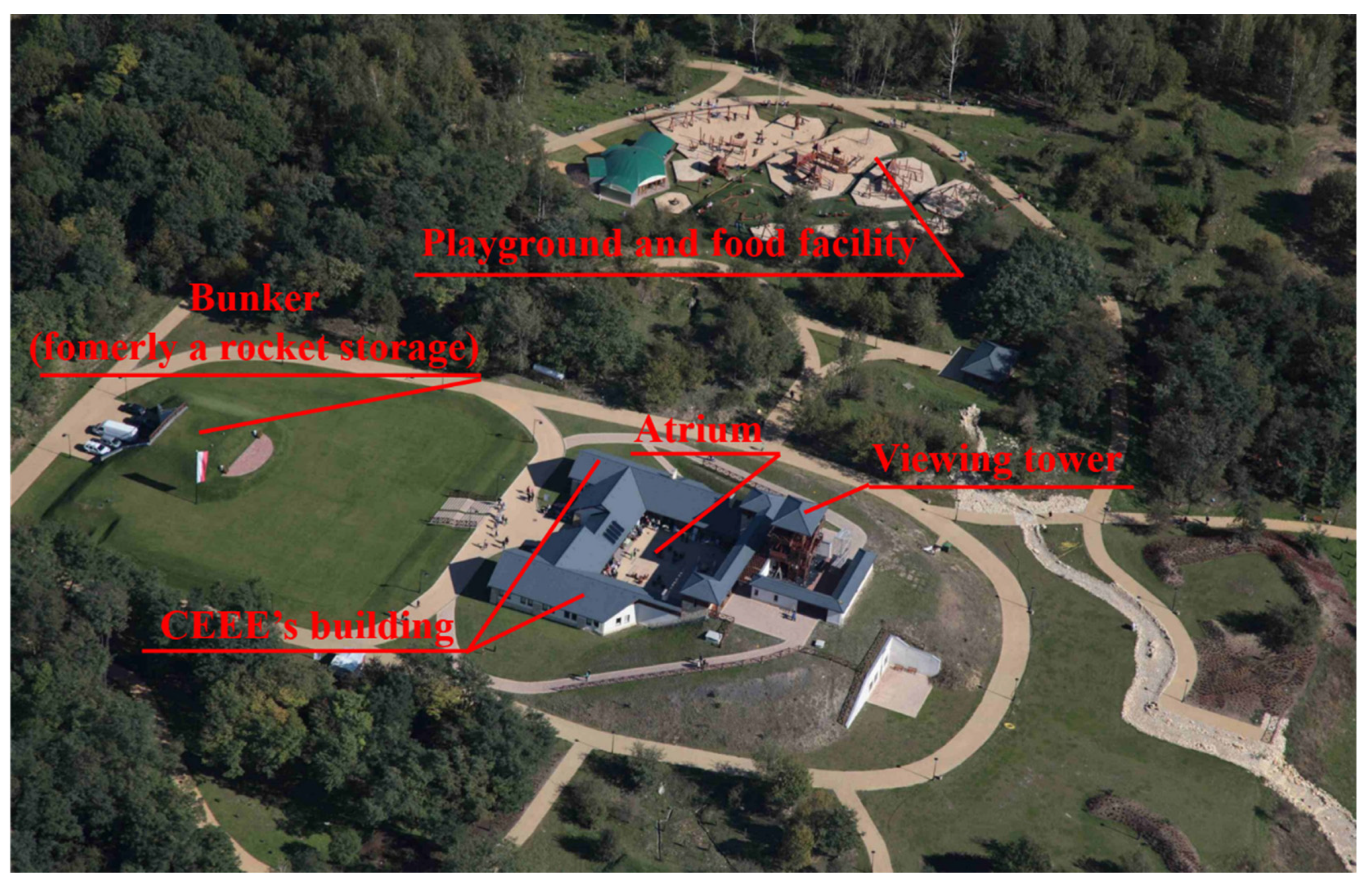
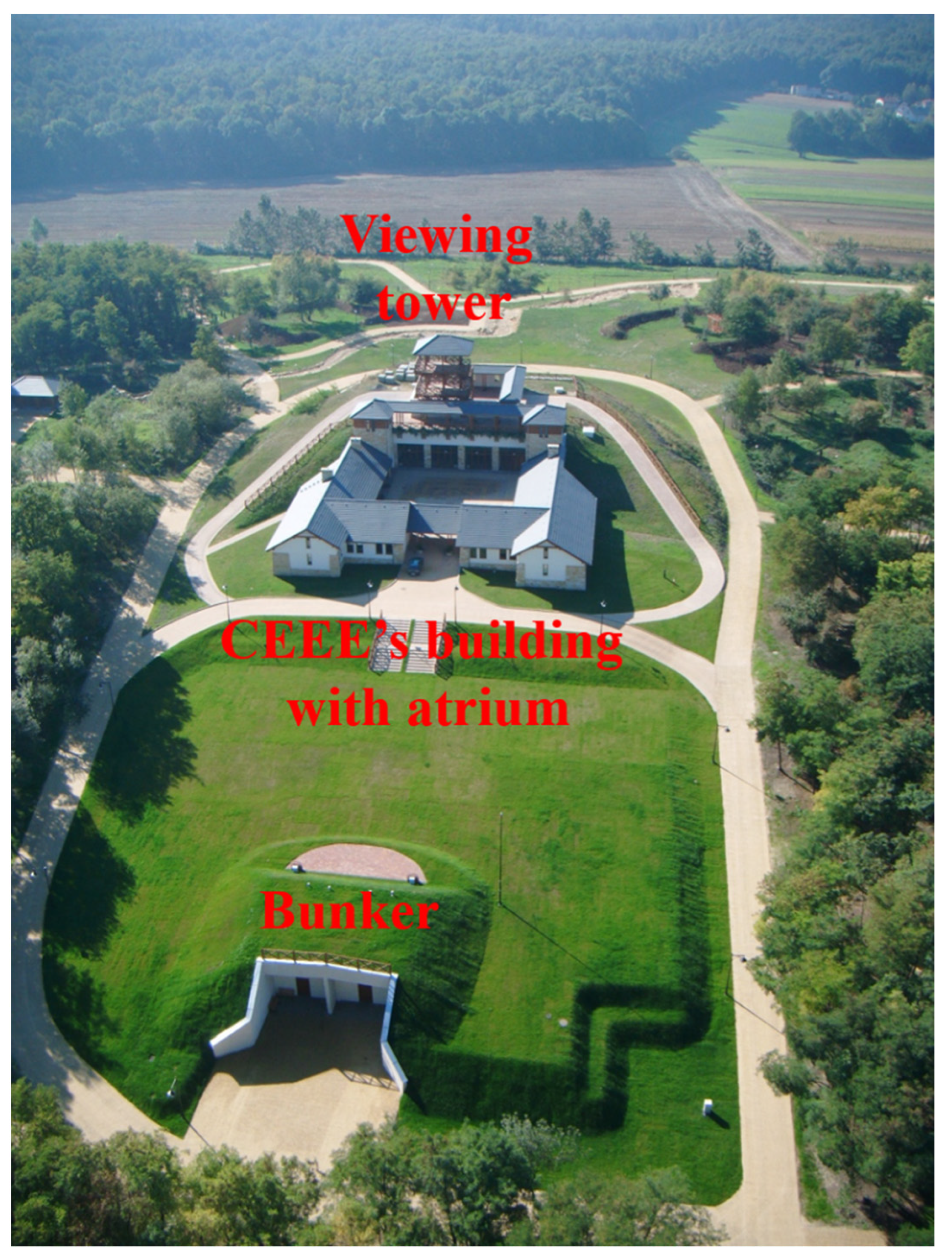
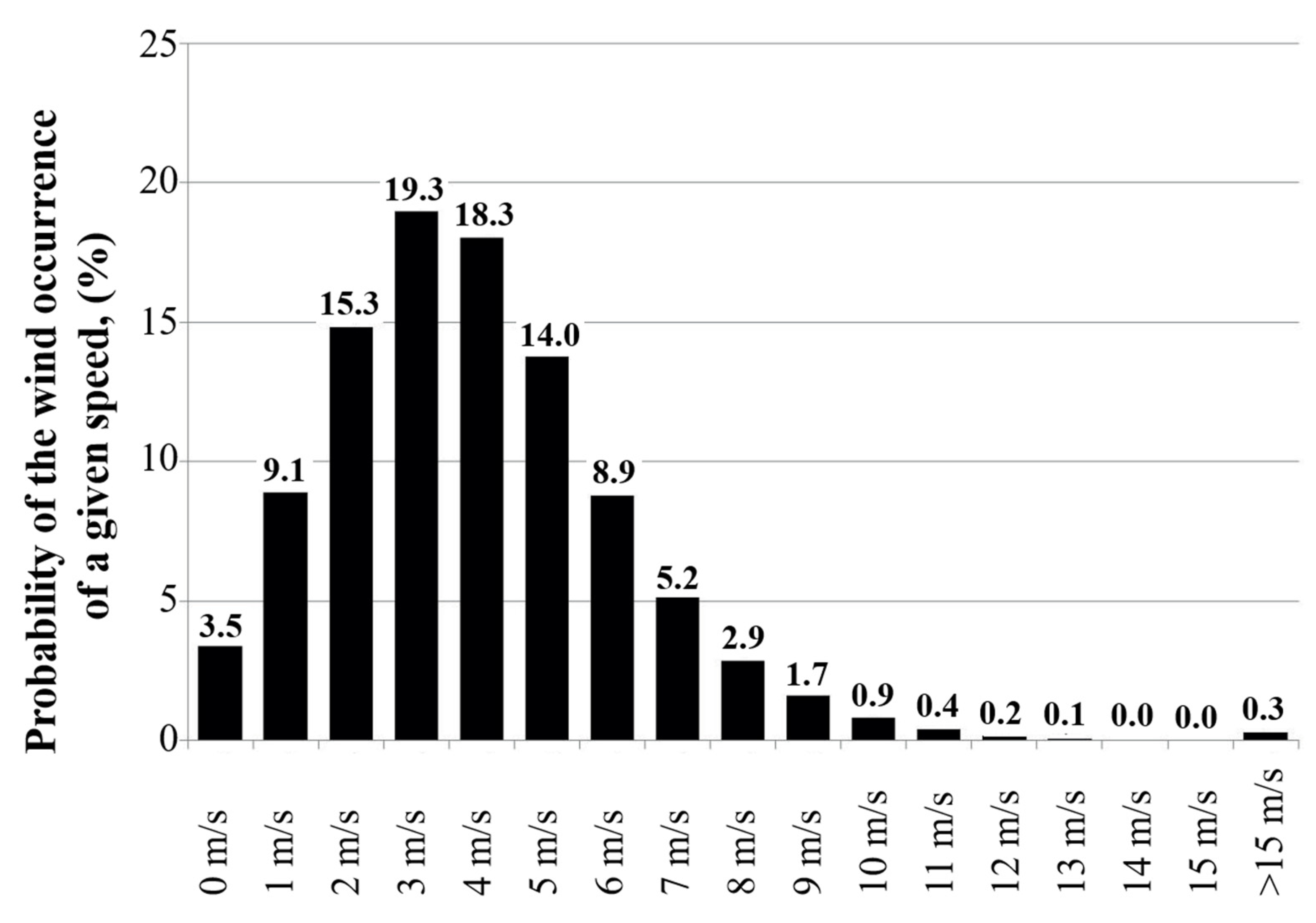
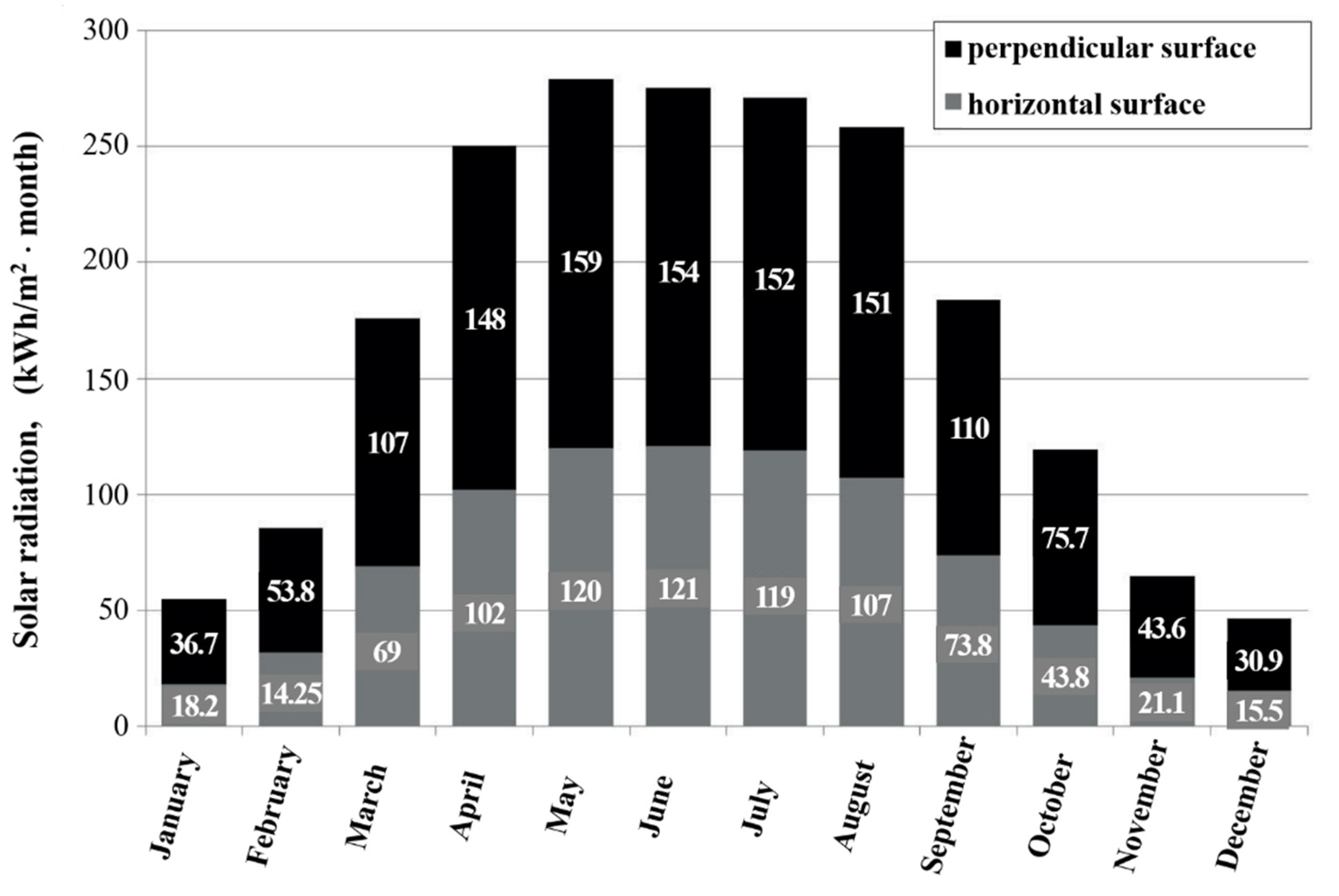
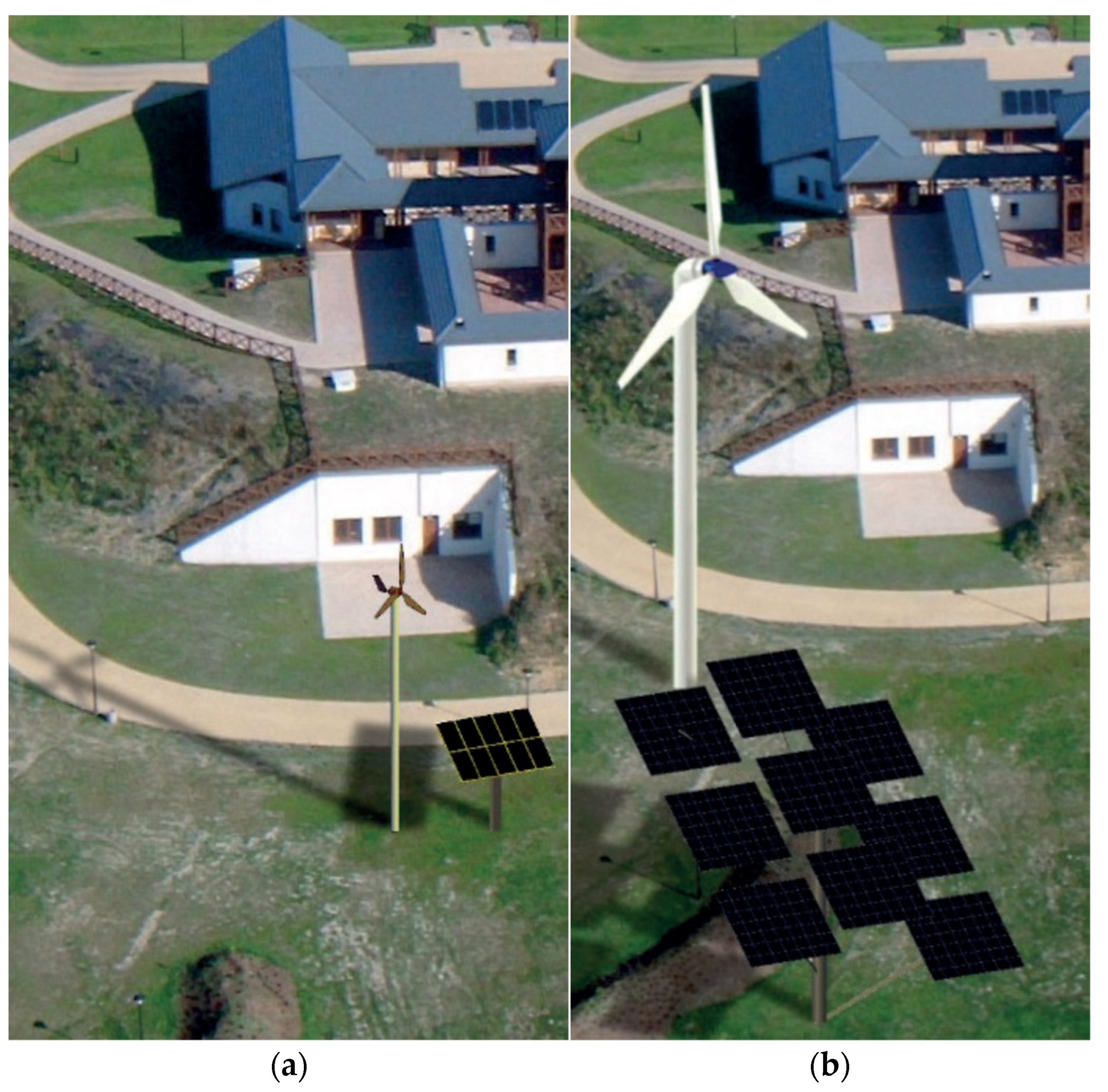
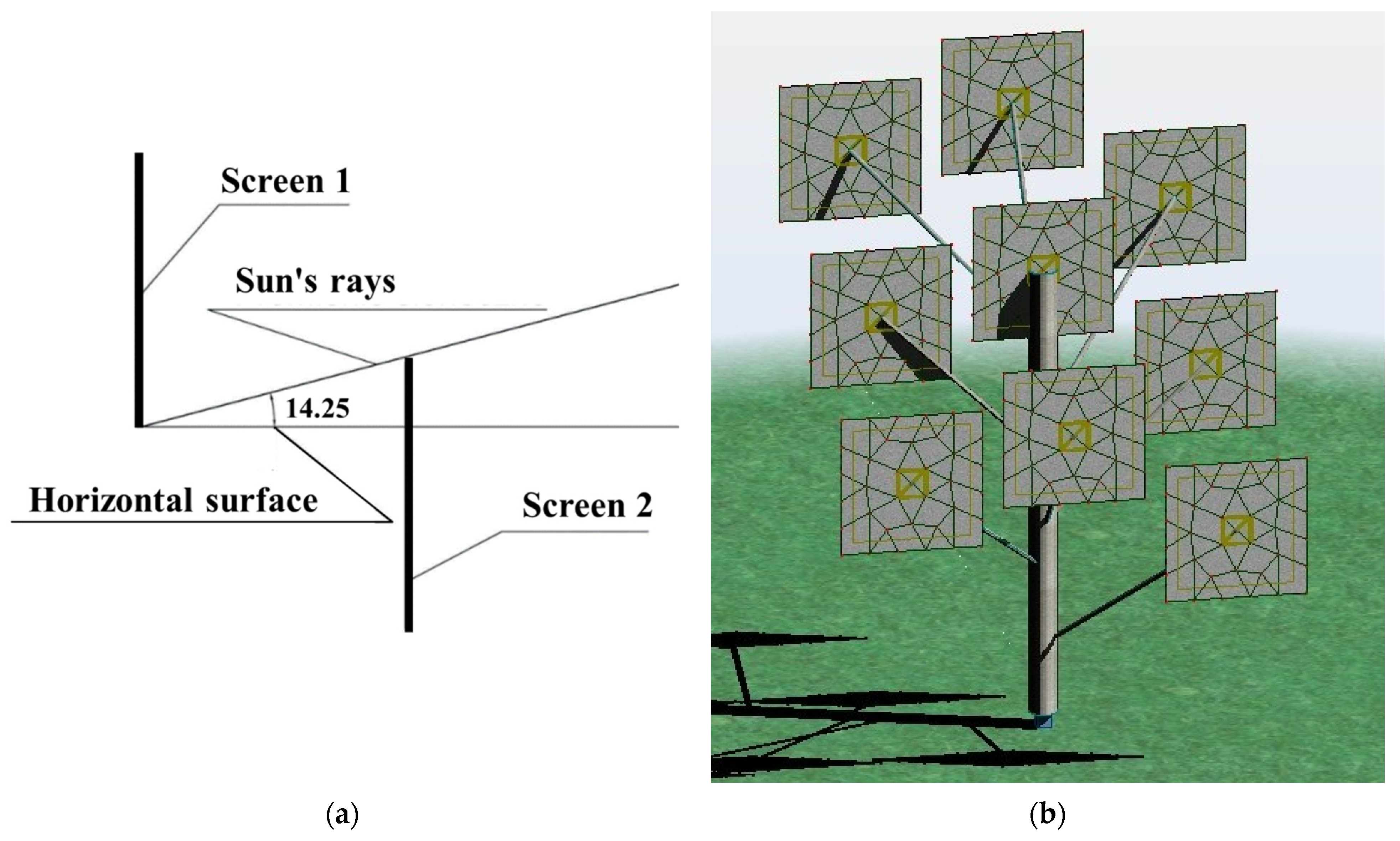

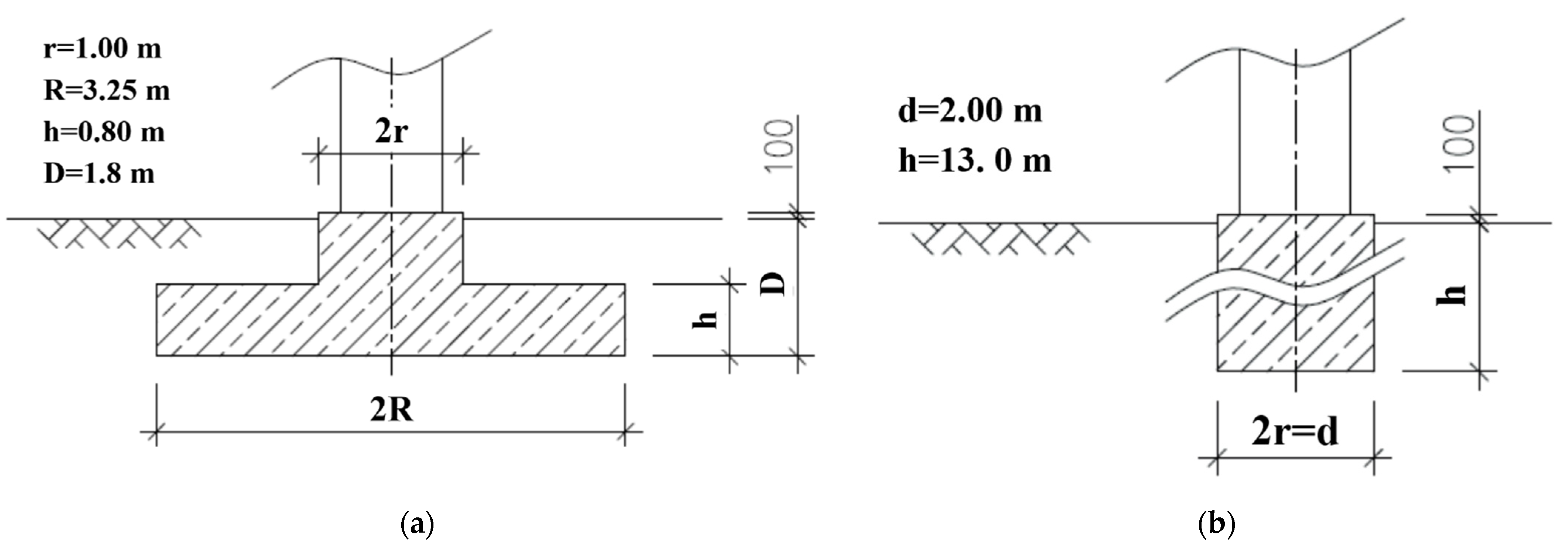

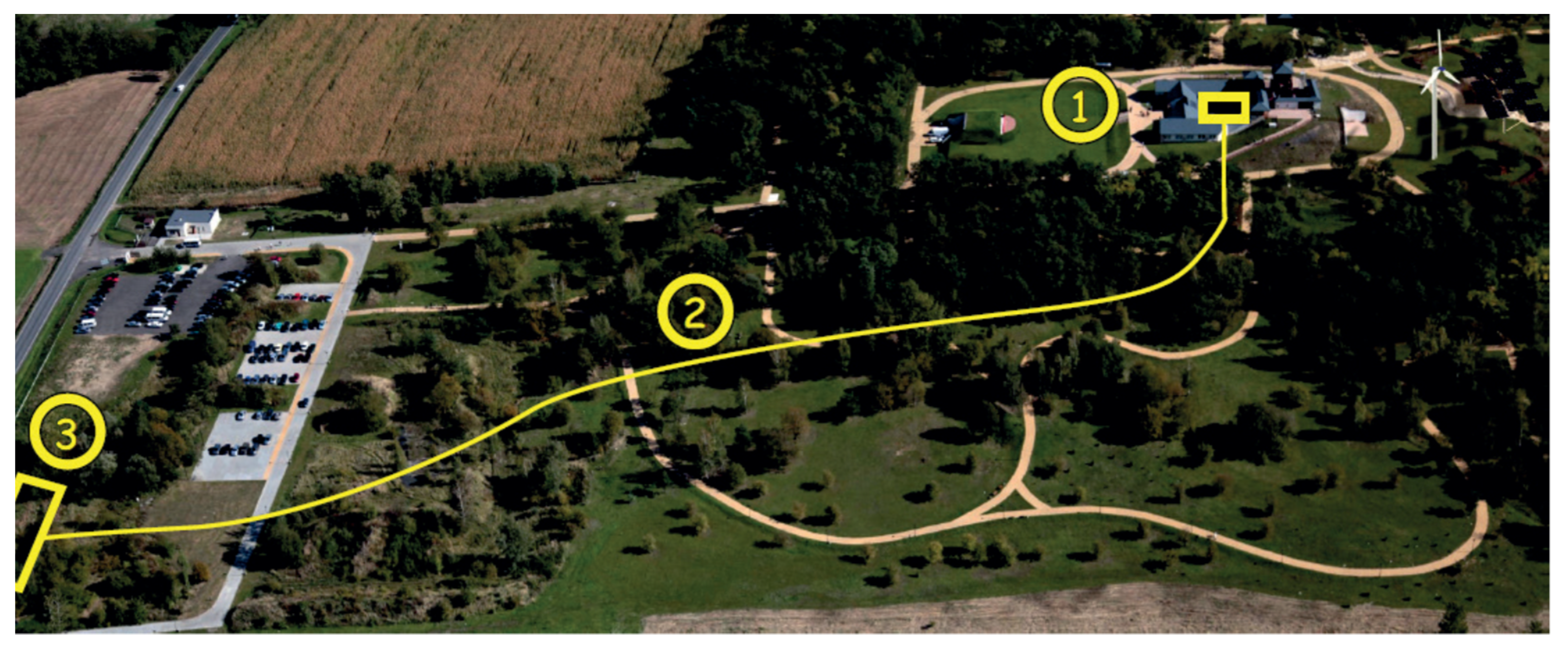


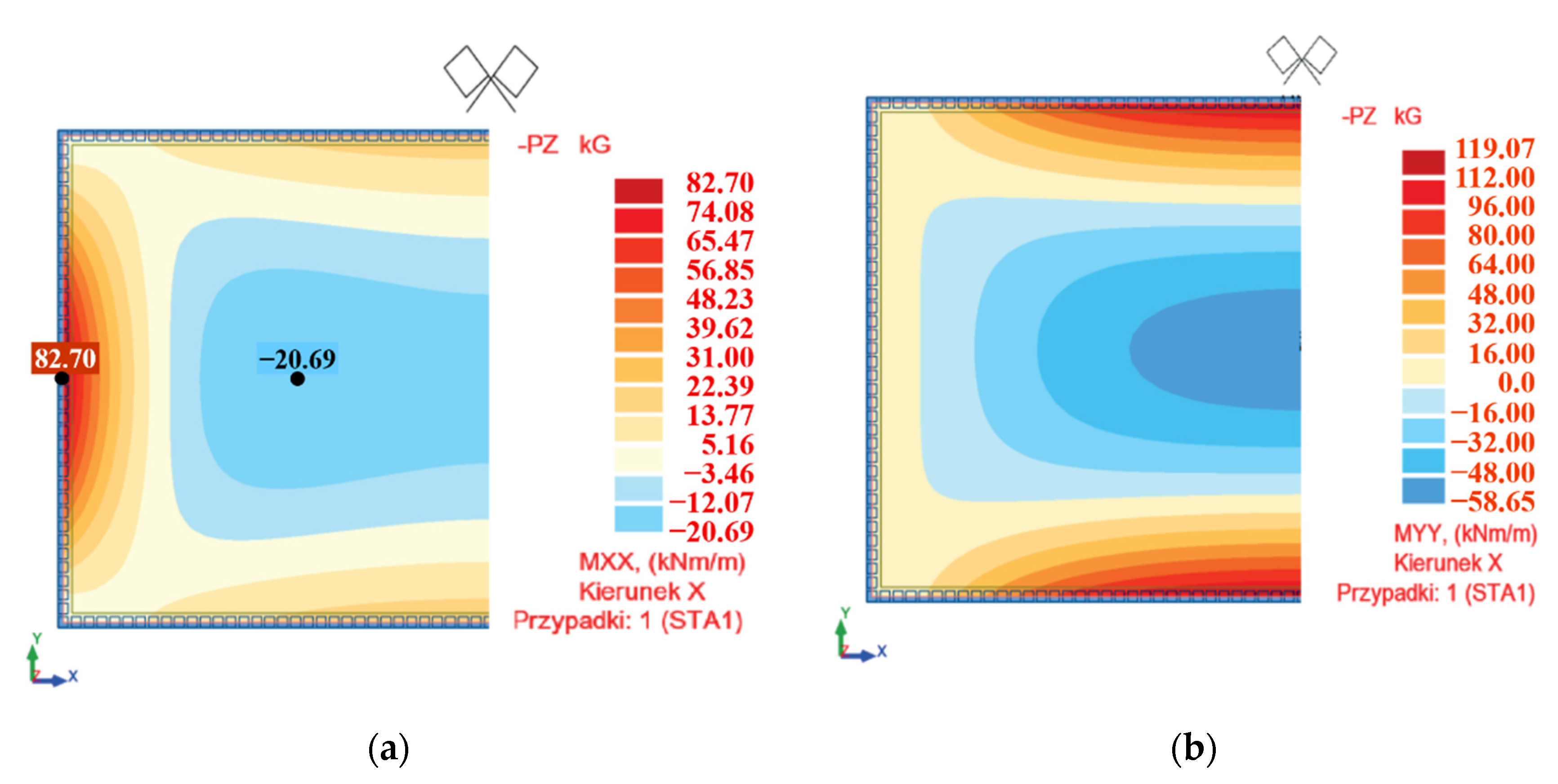
| Speed of Wind | Number of Recorded Measurements | Probability of Wind Occurrence of a Certain Speed | Speed of Wind | Number of Recorded Measurements | Probability of the Wind Occurrence of a Certain Speed |
|---|---|---|---|---|---|
| v | n | P(v) | v | n | P(v) |
| (m/s) | (pcs) | (%) | (m/s) | (pcs) | (%) |
| 0 | 1524 | 3.48 | 9 | 734 | 1.67 |
| 1 | 3983 | 9.08 | 10 | 377 | 0.86 |
| 2 | 6690 | 15.26 | 11 | 175 | 0.40 |
| 3 | 8469 | 19.31 | 12 | 77 | 0.18 |
| 4 | 8038 | 18.33 | 13 | 37 | 0.08 |
| 5 | 6133 | 13.99 | 14 | 16 | 0.04 |
| 6 | 3917 | 8.93 | 15 | 8 | 0.02 |
| 7 | 2287 | 5.22 | >15 | 130 | 0.30 |
| 8 | 1259 | 2.87 |
| Month | Average Insolation Per: | |
|---|---|---|
| Horizontal | Perpendicular | |
| Surface | Surface | |
| Monthly | Monthly | |
| Average | Average | |
| (kWh/m2·Month) | (kWh/m2·Month) | |
| January | 18.2 | 36.7 |
| February | 31.8 | 53.8 |
| March | 69.0 | 107.0 |
| April | 102.0 | 148.0 |
| May | 120.0 | 159.0 |
| June | 121.0 | 154.0 |
| July | 119.0 | 152.0 |
| August | 107.0 | 151.0 |
| September | 73.8 | 110.0 |
| October | 43.8 | 75.7 |
| November | 21.1 | 43.6 |
| December | 15.5 | 30.9 |
| ∑ | 842.2 | 1221.7 |
| Speed of Wind | Probability of the Wind Occurrence of a Certain Speed | SWIND 3200 | Zefir D21-P70-T18 | ||
|---|---|---|---|---|---|
| v | P(v) | Pt(v) | S | Pt(v) | S |
| (m/s) | (%) | (%) | (%) | (%) | (%) |
| [1] | [2] | [3] = [1] × [2] | [2] | [3] = [1] × [2] | |
| 0 | 3.48 | 0.00 | 0.00 | 0.00 | 0.00 |
| 1 | 9.08 | 0.00 | 0.00 | 0.00 | 0.00 |
| 2 | 15.26 | 0.00 | 0.00 | 0.41 | 0.06 |
| 3 | 19.31 | 2.19 | 0.42 | 2.84 | 0.55 |
| 4 | 18.33 | 5.31 | 0.97 | 7.70 | 1.41 |
| 5 | 13.99 | 10.31 | 1.44 | 15.60 | 2.18 |
| 6 | 8.93 | 17.19 | 1.54 | 28.57 | 2.55 |
| 7 | 5.22 | 27.50 | 1.43 | 46.20 | 2.41 |
| 8 | 2.87 | 40.63 | 1.17 | 68.08 | 1.95 |
| 9 | 1.67 | 57.19 | 0.96 | 97.26 | 1.63 |
| 10 | 0.86 | 75.63 | 0.65 | 100.00 | 0.86 |
| 11 | 0.40 | 98.75 | 0.39 | 100.00 | 0.40 |
| 12 | 0.18 | 121.56 | 0.21 | 100.00 | 0.18 |
| 13 | 0.08 | 130.63 | 0.11 | 100.00 | 0.08 |
| 14 | 0.04 | 134.69 | 0.05 | 100.00 | 0.04 |
| 15 | 0.02 | 136.25 | 0.02 | 100.00 | 0.02 |
| >15 | 0.30 | 0.00 | 0.00 | 0.00 | 0.00 |
| ∑ | 9.37 | ∑ | 14.32 | ||
Publisher’s Note: MDPI stays neutral with regard to jurisdictional claims in published maps and institutional affiliations. |
© 2022 by the author. Licensee MDPI, Basel, Switzerland. This article is an open access article distributed under the terms and conditions of the Creative Commons Attribution (CC BY) license (https://creativecommons.org/licenses/by/4.0/).
Share and Cite
Jastrzębska, M. Installation’s Conception in the Field of Renewable Energy Sources for the Needs of the Silesian Botanical Garden. Energies 2022, 15, 6598. https://doi.org/10.3390/en15186598
Jastrzębska M. Installation’s Conception in the Field of Renewable Energy Sources for the Needs of the Silesian Botanical Garden. Energies. 2022; 15(18):6598. https://doi.org/10.3390/en15186598
Chicago/Turabian StyleJastrzębska, Małgorzata. 2022. "Installation’s Conception in the Field of Renewable Energy Sources for the Needs of the Silesian Botanical Garden" Energies 15, no. 18: 6598. https://doi.org/10.3390/en15186598
APA StyleJastrzębska, M. (2022). Installation’s Conception in the Field of Renewable Energy Sources for the Needs of the Silesian Botanical Garden. Energies, 15(18), 6598. https://doi.org/10.3390/en15186598







